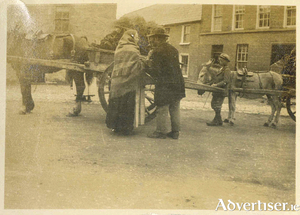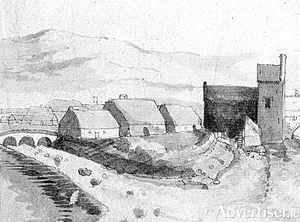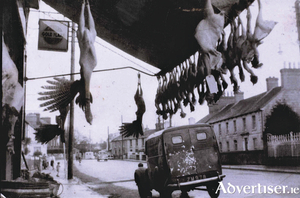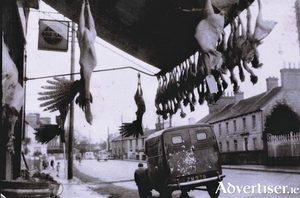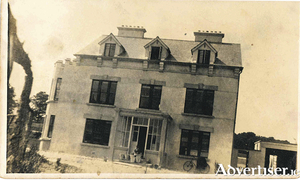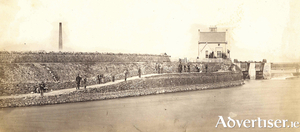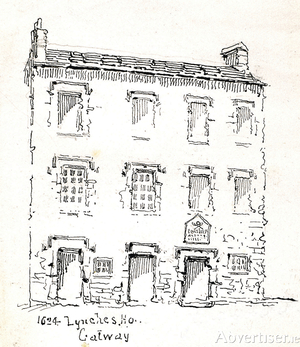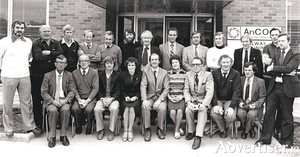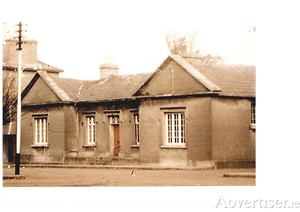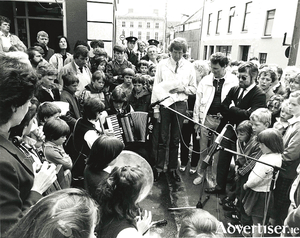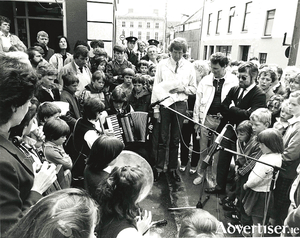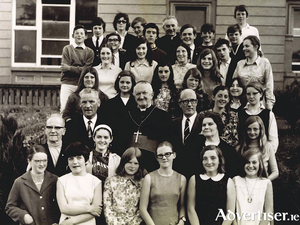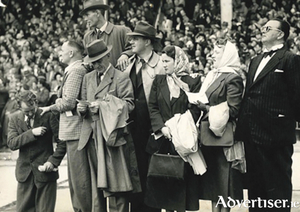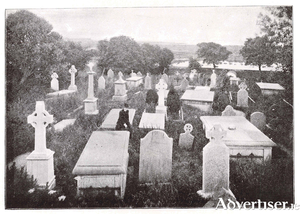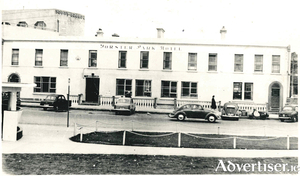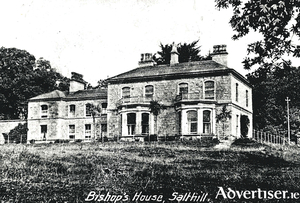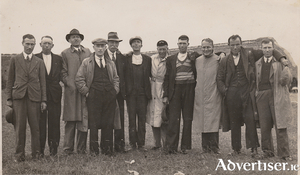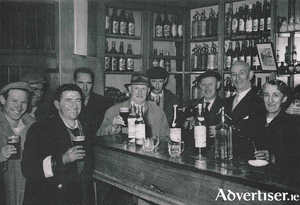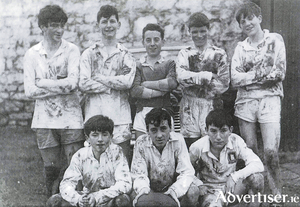The turf market at Raven Terrace
Thu, Oct 10, 2019
Turf was an important and indigenous fuel and so turf markets were an important factor in Galway life (long before anyone ever thought of carbon emissions), especially at this time of year as one prepared to head into winter. Farmers from Rahoon or Barna or surrounding areas would bring their neatly stacked cartloads of turf into town and sometimes go from door to door trying to sell their product. Those who did not have particular customers more often than not would go to designated turf market locations such as Eyre Square, Woodquay, the Small Crane, or Raven Terrace/Garryglass at the corner of Wolfe Tone Bridge. There was a weighbridge opposite where the fire station is now, and this was often used in their transactions. Having sold or bartered their turf, the farmer would then deliver it to the customer.
Read more ...Balls Bridge, 1685
Thu, Oct 03, 2019
This drawing is of a detail from “A Prospect of Galway” drawn by Thomas Phillips in 1685. It shows the southern end of the middle suburb with Balls Bridge on the left, and the bit of an arch you can see on the far right was part of the West Bridge. Balls Bridge is the bridge over what is now the canal between Upper and Lower Dominick Street, and the buildings we are looking at would be the backs of Lower Dominick Street as seen roughly from across the road from where the Fisheries Tower is today. The West Bridge is where O’Brien’s Bridge is today.
Read more ...Tim O’Leary’s shop, Lower Salthill
Thu, Sep 26, 2019
Tim O’Leary was a native of Roscommon who came to Galway to work as a buyer for Moons. He eventually bought this corner building opposite the Industrial School and changed it into a thriving business. It was a high-class grocery which sold fruit, minerals, and all kinds of confectionery. He operated it almost like a modern day supermarket in that you selected your own goods and brought them to the counter to pay. He had an ice cream saloon attached — “Try one of our ‘Frigidaire’ ices” — and would prepare “special gift parcels of sweets, chocolate, fruit and cakes at shortest notice for hotel guests”. He was a very entrepreneurial and imaginative businessman who worked very hard. He did deliveries all over Salthill and, as most houses left the key in the door in those days, he would just walk in, put the groceries on the kitchen table, and be gone quickly. My mother used to say she was always glad she was not in the bath when he arrived.
Read more ...Tim O’Leary’s shop, Lower Salthill
Wed, Sep 25, 2019
Tim O’Leary was a native of Roscommon who came to Galway to work as a buyer for Moons. He eventually bought this corner building opposite the Industrial School and changed it into a thriving business. It was a high-class grocery which sold fruit, minerals, and all kinds of confectionery. He operated it almost like a modern day supermarket in that you selected your own goods and brought them to the counter to pay. He had an ice cream saloon attached — “Try one of our ‘Frigidaire’ ices” — and would prepare “special gift parcels of sweets, chocolate, fruit and cakes at shortest notice for hotel guests”. He was a very entrepreneurial and imaginative businessman who worked very hard. He did deliveries all over Salthill and, as most houses left the key in the door in those days, he would just walk in, put the groceries on the kitchen table, and be gone quickly. My mother used to say she was always glad she was not in the bath when he arrived.
Read more ...The Warwick Hotel
Thu, Sep 19, 2019
Mrs Holmes was a relation of the O’Hara-Burkes who owned Lenaboy Castle and the Lenaboy Estate. She persuaded them to sell some of their land, ‘the lower pasturelands’ farthest away from the house, down near the gates of the estate to be precise. There, she built the house in our photograph, which became known as Greenmount. She ran it as a B&B but eventually it became too big for her and she converted some farm buildings in what we now know as Lenaboy Park and built herself a small house.
Read more ...Reconstruction of the Galway Fishery
Thu, Sep 12, 2019
Based on the McMahon Report, a survey involving the engineers of the Commissioners of Public Works in consultation with local businessmen and anglers, works were undertaken to improve drainage, to facilitate navigation, and to provide waterpower to the many mills in Galway. Waterpower was the bedrock on which the industry of Galway city was based, and by the mid-19th century there were some 30 mills in the city with associated headraces and tailraces which resulted in an intricate network of small waterways, which greatly added to the charm of Galway.
Read more ...The Lynch window
Thu, Sep 05, 2019
In 1807, the Reverend Edward Mangin wrote a three-volume romantic novel entitled George the Third in which he headed one of the chapters “Which would not have appeared had it not been written”. In it he invented a story about the Mayor of Galway, James Lynch Fitzstephen, hanging his son. Thirteen years later James Hardiman published his History of Galway in which he slightly changed, and greatly elaborated on, the story. This gave Mangin’s story a much wider audience, especially in this country, and so the legend became history. It was copied by many writers over the last 200 years, books written, plays written, films made, etc.
Read more ...ANCO, fifty years a-growing
Thu, Aug 29, 2019
The year 1967 saw a great change in Galway as the industrial estate was being developed as a result of the Government’s decision to designate Galway as a development location, a place which would be the commercial, financial, educational, health, social, and administrative centre of the region. The IDA was buying land and building factories in anticipation of attracting industry to the county. It is a measure of its success that within two years, on Monday November 10, 1969, ANCO (An Comhairle Oiliúna) opened a new training centre on the estate.
Read more ...The Parochial School
Thu, Aug 22, 2019
This is the time of the year when children are preparing to go back to school, a time when many of us would think back to our own schooldays, the happiest days of our lives.
Read more ...Street festivals
Thu, Aug 15, 2019
The first street festival held during the Quincentennial year of 1984 in Galway was organaised by High Street, Cross Street, and Quay Street from April 23 to 29. It was opened by Mayor Michael Leahy with the Army Pipe Band, St Patrick’s Brass band, St Patrick’s Boys' Band, Renmore Brass Band, and the Dockers Fife and Drum Band all playing on the streets. Later that evening, Gerry Macken’s Big Band played to a huge crowd from the back of a large truck which was drawn up across the street at the crossroads.
Read more ...Street festivals
Wed, Aug 14, 2019
The first street festival held during the Quincentennial year of 1984 in Galway was organaised by High Street, Cross Street, and Quay Street from April 23 to 29. It was opened by Mayor Michael Leahy with the Army Pipe Band, St Patrick’s Brass band, St Patrick’s Boys' Band, Renmore Brass Band, and the Dockers Fife and Drum Band all playing on the streets. Later that evening, Gerry Macken’s Big Band played to a huge crowd from the back of a large truck which was drawn up across the street at the crossroads.
Read more ...Lifesavers all
Thu, Aug 08, 2019
Tuesday November 20, 1984, was a sad day in Galway. It was the day Jimmy Cranny died, and though he had no family, his extended family of many thousands of people he had taught to swim mourned him and marked the passing of a legend. He could be seen at the seashore virtually every evening of the summer for many, many, years teaching children the basics of swimming, and as some of them progressed to competitive swimming, he provided early morning training sessions for them at the canal on a daily basis.
Read more ...One hundred and fifty years racing at Ballybrit
Thu, Aug 01, 2019
We know that horse races were organised in different parts of County Galway from the middle of the 18th century, in places like Kilconnell, Eyrecourt, Rahasane, Ballinasloe, Ballymoe, Carraroe, and Bermingham House near Tuam. They were known as ‘racing matches’. In 1764, there was a five day meeting held at Knockbarron near Loughrea, and between 1829 and 1857, 15 meetings were held in Kiltulla near Ballybrit. In 1867, a series of races was organised at Bushfield near Oranmore.
Read more ...Forthill Cemetery, 1905
Thu, Jul 25, 2019
It is often said that one cannot claim to be a true ‘old Galwegian’ or ‘auld shtock’ unless one has some relations buried in Forthill Cemetery at Lough Atalia. It is probably the oldest cemetery in Galway. The Augustinians have been associated with it since the year 1500. The Augustinian convent or priory was built there by Margaret Athy at the request of a friar, Richard Nagle, and it probably stood on level ground at the upper level of Forthill. The grounds of the priory extended quite a bit along the shores of Lough Atalia, at least to the site where St Augustine’s Well is today. Nothing at all remains of the priory except some drawings on the 1625 and 1651 maps.
Read more ...The Forster Park Hotel
Thu, Jul 18, 2019
There was a long discussion at an Urban District Council meeting in July 1935 about whether to allow purchasers of plots in front of the house at Forster Park, recently occupied by Dr Michael O’Malley, to proceed with the building immediately, or to force them to defer construction until the road along the Promenade had been widened. The plots had been advertised as building sites. One of the objectors said, “We are a long time looking for a town planning scheme in Galway, and now that we have it, I strongly object to this building. We have one of the finest hotels in the country (The Eglinton) and now you want to destroy it.”
Read more ...Mount St Mary’s
Thu, Jul 11, 2019
In the late 12th century, the Diocese of Annaghdown came into existence in the area surrounding the city of Galway. In 1324 it was united with Tuam, but the Anglo-Norman families refused to accept direction from Tuam. In 1484 Pope Innocent VIII made St Nicholas’ Church a Collegiate Church governed by a warden (not a bishop) and eight vicars. Edmund ffrench, the last warden, was made Bishop of Kilmacduagh in 1824. On April 27, 1831, the Bull ‘Sedium Episcopalaism’ was issued by Pope Gregory XVI erecting the Diocese of Galway. On October 23, 1831, the first Bishop of the Diocese, George Joseph Plunkett Browne, was consecrated, and in 1844 he was succeeded by Laurence O’Donnell. John McEvilly became Bishop in 1857.
Read more ...Menlo oarsmen
Thu, Jul 04, 2019
One of the great sporting achievements of the last century was the remarkable success of a group of Irish speaking farmers and local men from Menlo. During a very wet spring when they could do little work on their farms or on the bog, as they watched rowing crews going up and down the river, a group of them decided to form a rowing club. They asked to become members of Menlo Emmetts Hurling Club and adopted the name. Many of them would have spent a lot of time on the river, but that did not mean they knew how to handle a racing boat. When they took their clinker out for the first time, it took them a good while to steady the boat. A local man watching, described them as “The Wobblers” and this name stuck for a few years.
Read more ...Hughes’ Pub, Woodquay
Thu, Jun 27, 2019
Sixty years ago yesterday, on June 26 1969, Michael Hughes opened his pub in Woodquay. Our photograph (which was taken in 1953) shows what it looked like before Michael took it over. It was known as Molly Greaney’s and that is the lady herself on the right. Next to her is her brother Tommy who worked as a rep for Dwyers of Cork. The next two men with caps are Brendan Noonan and his brother, and their father is the man with the hat. They were carpenters. The man in the foreground is Tommy O’Brien who worked with an oil company. We do not know who the two men in caps on the left were.
Read more ...Our Lady's Boys' Club
Thu, Jun 20, 2019
This club is one of Galway’s treasures. It was founded in 1940 by Fr Leonard Shiel SJ at a time when there were no after-school recreational facilities for working class-area boys in the city. The Jesuit Community gave them the use of a clubhouse at the back of the Columban Hall and here the boys were involved in many activities that helped prepare them for life. They were taught loyalty, self-respect, how to help others, and the importance of team spirit. Much of this was through the medium of sport — soccer, swimming, boxing, Irish dancing, table tennis, snooker, etc.
Read more ...St Nicholas’ Collegiate Church and the city
Thu, Jun 13, 2019
Next year the magnificent building of St Nicholas’ Collegiate Church, this venerable edifice in the centre of our city will celebrate
700 years of continuous Christian worship in Galway. The church is the largest medieval parish church in Ireland and its history is a kind of microcosm of the history of Galway. It is thought that it was first built early in the 14th century. There was a legend that a man from the Aran Islands died in the 16th century, aged 220 years who could remember a time when the building did not exist. It sounds like a good story.
Read more ...